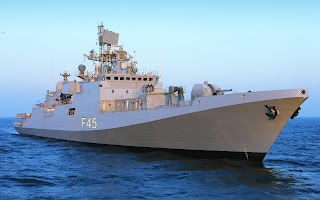An Indian Navy press release announcing the launch of its latest base on Lakshadweep Islands
INS Dweeprakshak, the latest Naval Base of Indian Navy was commissioned at Kavaratti in the Lakshadweep archipelago today by Vice Admiral KN Sushil, Flag Officer Commanding in Chief Southern Naval Command. The event marks an important mile stone in the Navy’s resolve to incrementally augment the security infrastructure at the strategically important Lakshadweep Islands. The commissioning ceremony was marked by grandeur and solemnity befitting the occasion.
A 50 men Guard was paraded in honour of the Commander in Chief on arrival. The ceremony of naming the establishment was performed by Smt Sunitha Ismail, Chairperson State Social Welfare Board. Thereafter Captain SM Hanchinal, Commanding Officer, read out the Commissioning Warrant and of the Naval Ensign was hoisted as the Southern Naval Command band played the National Anthem. Saying “Lakshadweep islands form the maritime frontiers of our country on the Western side” Vice Admiral KN Sushil noted that the commissioning of a full fledged Naval Base was another milestone in the commitment of the Indian Navy to maintain effective coastal surveillance and defence capability. The Admiral also complimented the crew of the INS Dweeprakshak and exhorted them to do their utmost in the discharge of their responsibilities. He also informed the gathering that radar stations and other surveillance measures were in place for shipping traffic monitoring and intelligence gathering.
Indian Navy has been operating a detachment at Kavaratti since early eighties. With the commissioning of INS Dweeprakshak, the island territories would see calibrated strengthening of assets in step with their growing relevance to the security calculus of the Nation. A firmer footing in the islands, which are spread out astride some of the busiest shipping lanes of the world would provide the necessary wherewithal to the Indian Navy to discharge its responsibilities suitably. Indian Naval Warships on patrol would now extend their reach farther with base support from INS Dweeprakshak.
Commanding Officer INS Dweeprakshak will also function as Naval Officer in Charge Lakshadweep and Minicoy. Dr N Vasanth Kumar Chairman of Lakshadweep Welfare Board, District Panchayat Member Shri Jallaluddin Koya, Commodore MR Ajaykumar, Naval Officer in Charge Kerala, Commodore Ajay Saxena, Chief Staff Officer Operations of Southern Naval Command, Mr Ajay Kumar Superintendent of Police and a large gathering of local community witnessed the function.
INS Dweeprakshak, the latest Naval Base of Indian Navy was commissioned at Kavaratti in the Lakshadweep archipelago today by Vice Admiral KN Sushil, Flag Officer Commanding in Chief Southern Naval Command. The event marks an important mile stone in the Navy’s resolve to incrementally augment the security infrastructure at the strategically important Lakshadweep Islands. The commissioning ceremony was marked by grandeur and solemnity befitting the occasion.
A 50 men Guard was paraded in honour of the Commander in Chief on arrival. The ceremony of naming the establishment was performed by Smt Sunitha Ismail, Chairperson State Social Welfare Board. Thereafter Captain SM Hanchinal, Commanding Officer, read out the Commissioning Warrant and of the Naval Ensign was hoisted as the Southern Naval Command band played the National Anthem. Saying “Lakshadweep islands form the maritime frontiers of our country on the Western side” Vice Admiral KN Sushil noted that the commissioning of a full fledged Naval Base was another milestone in the commitment of the Indian Navy to maintain effective coastal surveillance and defence capability. The Admiral also complimented the crew of the INS Dweeprakshak and exhorted them to do their utmost in the discharge of their responsibilities. He also informed the gathering that radar stations and other surveillance measures were in place for shipping traffic monitoring and intelligence gathering.
Indian Navy has been operating a detachment at Kavaratti since early eighties. With the commissioning of INS Dweeprakshak, the island territories would see calibrated strengthening of assets in step with their growing relevance to the security calculus of the Nation. A firmer footing in the islands, which are spread out astride some of the busiest shipping lanes of the world would provide the necessary wherewithal to the Indian Navy to discharge its responsibilities suitably. Indian Naval Warships on patrol would now extend their reach farther with base support from INS Dweeprakshak.
Commanding Officer INS Dweeprakshak will also function as Naval Officer in Charge Lakshadweep and Minicoy. Dr N Vasanth Kumar Chairman of Lakshadweep Welfare Board, District Panchayat Member Shri Jallaluddin Koya, Commodore MR Ajaykumar, Naval Officer in Charge Kerala, Commodore Ajay Saxena, Chief Staff Officer Operations of Southern Naval Command, Mr Ajay Kumar Superintendent of Police and a large gathering of local community witnessed the function.
















